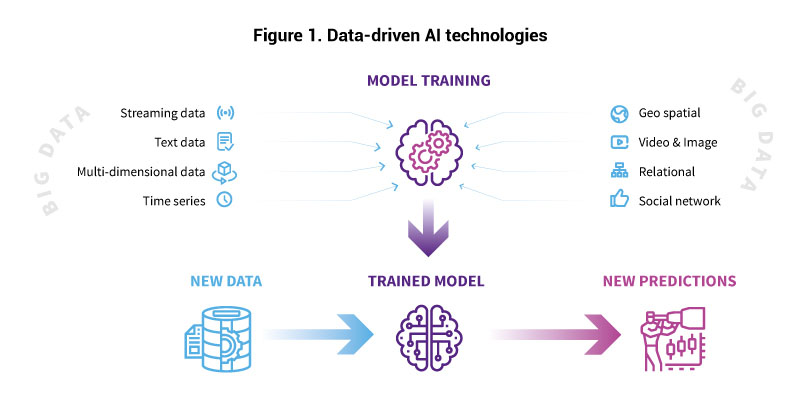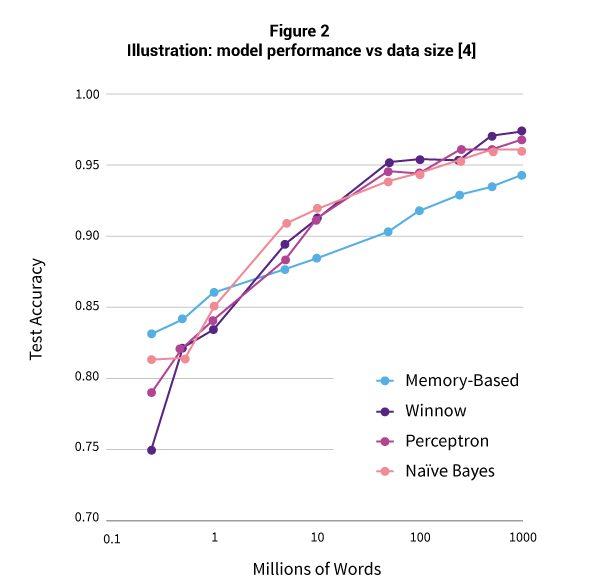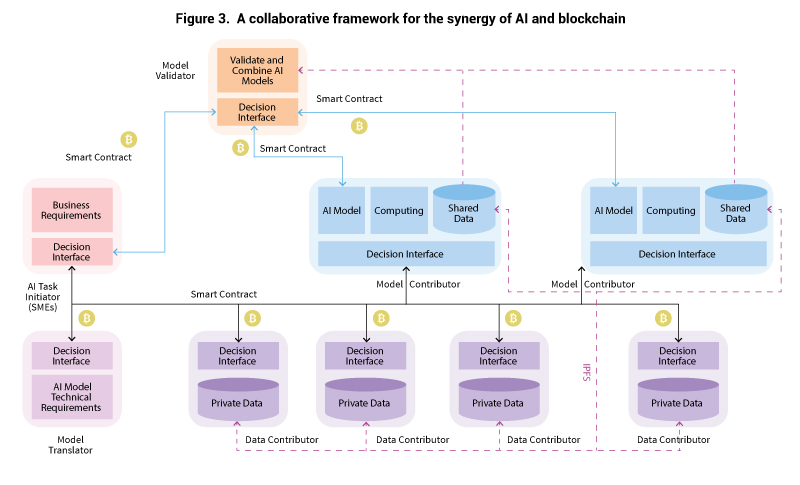By Yan Pang
The ability to make effective use of AI technology has hitherto remained in the province of large enterprises, with their access to huge amounts of data. Isn’t there some way that small and medium-sized businesses could also realise the potential of AI? Yan Pang believes there is, and here he explains how.
Across industries, artificial intelligence (AI) is changing the way large enterprises do business. However, small and medium enterprises (SMEs) have not been able to enjoy the dividends of the rapid development of AI technologies, due to the lack of data and talent. This paper discusses the challenges that SMEs are facing in the AI era and proposes a collaborative framework for an open AI market. The framework ensures the ethical use of data in an open AI market and empowers SMEs through the synergy of AI and blockchain. With this framework, SMEs can potentially overcome the challenges of data and talent, and benefit greatly from the rapid development of AI and blockchain technologies.
1. Introduction
In the past decade, we have witnessed the remarkable rise of artificial intelligence (AI). The technology has made a profound impact in many areas of our daily lives – from recommending products to customers in e-commerce platforms, to detecting fraud and risk in credit card transactions, to optimising traffic flows in transportation systems, to providing decision support to doctors in hospitals. AI has already become the top priority for many large enterprises as a catalyst in the digital transformation of industries. Across industries, AI is changing the way large enterprises do business and creating tremendous business value for them. According to Alibaba, their AI-powered chatbot can understand more than 90 percent of customers’ queries and serves more than 3.5 million users a day [1]. Google reports that an AI recommendation system has already delivered consistent energy savings of around 30 percent on average for Google’s highly optimised data centres [2]. In order to incorporate AI into enterprise operations and make a real business impact, there are two fundamental components, i.e., model and data. Modelling techniques are used to transform real-world business requirements into suitable mathematical AI models for scientific analysis. Data are used to train these AI models, so that they can make accurate predictions based on new data (Figure 1). While modelling techniques are still vital in building AI solutions [3], data becomes more and more critical in modern data-driven AI solution performance. Michele and Eric [4] presented a study of the effects of data size on machine learning models’ performance for natural language disambiguation. It showed that the performance of different machine learning techniques could benefit significantly from large training data sets. With small data (e.g., data size of 105), the best model is about x percent better than the worst model, whereas the performance improvement yielded by big data (e.g., data size of 109) is y%>>x% (Figure 2). Similarly, Gabriel and Michael [5] demonstrated that more data trumped smarter algorithms by comparing pointwise mutual information with latent semantic analysis.
From these studies, it is clear that data is critical for enterprises in order to implement AI solutions to improve their businesses. However, most valuable data are currently controlled by large enterprises, e.g., Google, Facebook, Alibaba, Tencent, etc. This is why most of the well-known AI success stories have come from these large enterprises in the past ten years. Although these large enterprises make substantial contributions to bringing AI solutions into our daily lives, more and more people ask an important question: how can small and medium enterprises (SMEs) also benefit from the rapid development of AI technologies? We all know that SMEs play a crucial role in most economies, particularly in developing countries. According to a recent World Bank report [6], SMEs account for the majority of businesses worldwide and are essential contributors to job creation and global economic development. They represent about 90 percent of businesses and more than 50 percent of employment worldwide. Currently, SMEs have not been able to enjoy the dividends of AI, due to the lack of data and talent. SMEs do not usually have a large volume of data compared to large enterprises. Besides, it is hard for them to attract AI experts, due to intense competition for AI talent. With all these constraints, do SMEs still stand a good chance of competing with large enterprises in the AI era, as they did in the Internet era? Twenty years ago, many innovative SMEs, e.g., Alibaba, Google and Facebook, quickly stood out from the competition with large enterprises and grew up to be tech giants in the Internet era. Can SMEs replicate the same success stories in the AI era? It is a big question mark. For SMEs to emerge in the AI era, the challenges of data and talent must be addressed. Recently, blockchain, a peer-to-peer, decentralised network technology, has come to be considered as a promising solution to overcome these challenges.

2. Blockchain Technology Empowers SMEs In The AI Era
Blockchain technology can potentially be used to build a collaborative, open AI market [7] for SMEs. By this means, SMEs can collaborate effectively to overcome the challenges in data and talent, and develop successful AI solutions.
2.1. Key blockchain concepts and an open AI market
The fundamental building blocks of blockchain include a decentralised network, a consensus algorithm, cryptography and a smart contract. All these play essential roles in building an open AI market for SMEs.

Decentralised network
A blockchain is an open ledger of information collected through a decentralised peer-to-peer network that sits on top of the Internet. Peer-to-peer networks are participatory systems that resist control by a single, centralised superpower. The participants establish agreed-on rules that evolve as the need or complexity arises. By distributing power and value across a global, decentralised network, the exchange of information and value can become more efficient, equitable and open. Blockchains are not controlled by any central authorities but by the entire network of participants, who establish the rules for participation and elect to evolve the system according to consensus. This makes them censorship-resistant and inherently more elastic than most other decision-making mechanisms for large groups of participants. Using blockchain technology, SMEs can work together and build a collaborative network for different participants to contribute business use cases, data and AI models. This collaborative network is not controlled by any centralised organisations, but benefits the whole SME ecosystem.
Consensus algorithm
A consensus protocol is a procedure through which all the peers on the blockchain decentralised network reach a common agreement about the present state of the open ledger. In this way, consensus protocols achieve reliability in the blockchain network and establish trust between unknown peers in a distributed computing environment. Essentially, the consensus protocol makes sure that every new block that is added to the blockchain is the only version of the truth that is agreed upon by all the active nodes in the network. From the data perspective, consensus protocols will decide: 1) who has the authority to add a new block of data on the blockchain; and 2) what data are included in the new block [8]. The consensus protocols ensure that the blockchain data are consistent in different nodes and reduce the risk of counterfeit data transactions. This improves data quality significantly, which is essential in building successful AI solutions.
Cryptography
Blockchains make use of two types of cryptographic algorithms, i.e., asymmetric-key algorithms and hash functions. The main application areas of asymmetric-key algorithms in blockchain are in public-private key management and digital signatures. Digital signatures provide integrity to the transaction process on blockchains. They are easily verifiable and cannot be corrupted, which ensures that the blockchain is valid and the data is verified and correct. Hash functions are used to provide the functionality of a single view of the blockchain to every participant and make the data block tamper-proof. Once a new data block is added to the blockchain, the hash value, i.e., a unique string of characters, of this block record is generated using hash functions, e.g., SHA (Secure Hash Algorithm)-256. Due to the collision-resistance property of hash functions, if anything inside a block changes, even just a single-digit change, the block will get a completely different hash value [9]. Cryptography technologies are the core of blockchain, making the blockchain data immutable and reliable. Also, data privacy and confidentiality can be well protected on blockchains using cryptography technologies. All these are crucial to building a collaborative and open AI platform for SMEs.
Smart contract
Smart contracts are lines of computer code that are stored on a blockchain and automatically execute when predetermined terms and conditions are met. They are programs that run as they have been set up to run by the developers at the most basic level. The benefits of smart contracts are most apparent in business collaborations, in which they are typically used to enforce some agreements, so that all participants can be certain of the outcome without the involvement of an intermediary [10]. Through smart contracts, blockchain technologies can potentially facilitate decentralised coordination and alignment of incentives on a scale that only centralised, top-down structures previously could. Coordinating groups of trustless participants on the decentralised blockchain network and getting them to behave in productive and peaceable ways can be achieved using smart contracts. In an open AI market, we can create a fair incentive mechanism on smart contracts. It ensures that all the participants in the blockchain, e.g., data contributor, model contributor and validator, can receive fair rewards if their contributions lead to real-world business value.
2.2. Data ethics in the open AI market
Although large enterprises control most of the data, SMEs and consumers are the creators of these data. In an open AI market, data ethics, which is about how data are collected and used, is crucial. A thriving open AI market should be held to a higher ethical standard that creates business values alongside the requirements of laws and regulations. Data ethics can, therefore, bridge the gap between legal requirements and business value creation. In fact, the ethical use of data makes good business sense for SMEs to collaborate in the open AI market. Respectful and fair use of data can improve business reputation and enhance market confidence. When the open AI market ensures that personal data is used ethically through blockchain technologies, individuals will have greater confidence in their data being protected. In turn, customers’ trust will grow and become a competitive edge for the open AI market.
Blockchain technology, by design, offers a trustworthy solution to data collection, exchange and analysis. In a blockchain decentralised network, the peers share access to an open ledger, which serves as the trusted, append-only database and the single source of transactional data. The consensus algorithms ensure that only the data which are trusted by the majority of the peer nodes will be added to the blockchain. The data exchanges on the blockchain are well protected by cryptographic technologies and smart contracts. Ethics policies can also be implemented as smart contracts in the blockchain. Whether data are biased or whether AI models meet ethics requirements can be added to the blockchain open ledger. Therefore, the blockchain peer nodes will know if the data and models meet ethics requirements, and decide whether to build AI solutions on top of that.
3. A Proposed Framework For An Open AI Market
Section 2 describes how blockchain can help to build a collaborative open AI market for SMEs. A detailed framework is proposed in this section through the synergy of AI and blockchain technologies (Figure 3). In the current Internet framework, although SMEs and consumers are the creators of the majority of the valuable Internet data, large enterprises gain most of the business value generated by these data. There is no effective mechanism to return the business value to the true data creators. With blockchain technologies, SMEs and consumers can potentially become the true owners of their data and enjoy the business value created using their own data. An autonomous, open data platform can be built using blockchain technologies. Proper incentive models can be designed using smart contracts to encourage data owners to share data on this framework. Therefore, the power of AI is no longer controlled only by large enterprises, but benefits the SMEs.

In the proposed collaborative, open AI framework, there are five different types of participants: 1) AI task initiators, 2) model translators, 3) data contributors, 4) model contributors and 5) model validators. Each participant is completely autonomous and responsible for its own individual behaviour. The AI task initiators are usually SMEs. Although SMEs do not have the expertise and data to build and train the AI models, they usually have a deep understanding of business. They can identify valuable AI use cases that potentially generate tremendous business values. The AI task initiators will describe the AI tasks using business language, e.g., business context and objectives, and define financial compensation commitments. Some AI business task templates can be provided in the collaborative framework to help the SME task initiators to explain the AI business tasks more accurately. These AI tasks will be automatically packaged into smart contracts and published on the decentralised blockchain network.
Once the AI tasks are published, the model translator nodes on the blockchain network will receive the business requirements. They will then transform these business requirements into AI model technical requirements, e.g., input data, model evaluation criteria, output data, etc. These AI model technical requirements will then be broadcast on the blockchain network using smart contracts. The corresponding relationship between original AI business tasks and model technical requirements will be defined in the smart contracts.
After the AI model’s technical requirements are defined, the decentralised nodes in the blockchain network will know what kinds of data are required by the AI task. Some of the nodes might have relevant data for AI model training. These potential data contributors can evaluate financial compensation commitments defined in the smart contract and decide whether they participate in this AI task. If they choose to contribute to the AI task, they can share their dataset via decentralised storage (DS), such as the Interplanetary File System (IPFS) [11]. These shared data will be well protected using DS and cryptography techniques. Therefore, the rights and interests of data contributors can be well protected.With clear business requirements, technical requirements and shared datasets, model contributors can build and train suitable AI models. The model contributors train the AI models locally for a given task by using either a local data asset or the data shared by the associated data contributors. After training the local AI model successfully according to the criteria defined by the model translator via smart contracts, such as an accuracy score above 90%, the model contributors announce the completeness of the training and share the AI model to the blockchain network via the DS. Federated learning (FL) technologies [12] can be used at this stage to create high-performance AI models for the tasks, while protecting data privacy.
The available model validators are selected by the blockchain network using proper consensus protocols [13] to verify the contributions of the locally trained learning models. The verification is conducted according to the criteria defined by the model translators via smart contracts, such as whether the accuracy can be improved after fusing the claimed model. The majority voting amongst the model validators is used to determine the contribution of the corresponding model contributors. The AI task initiator is informed about the majority voting conclusion. If this conclusion is positive, the transaction of the verified locally trained AI model, also called the private model, is established between the AI task initiator and the associated contributors, i.e., model translator, data contributor, model contributor and model validator. Therefore, these contributors receive financial compensation and the AI task initiator obtains access to the AI model in IPFS. Additionally, the model validators involved in the task also get compensated by the initiators for their effort. After the time window assigned to the AI task ends, the application initiator fuses all the received verified private models to achieve the metamodel that will be applied to address the AI task.
In this framework, a node in the blockchain network can participate in the role of model translator, data contributor, model contributor and model validator at the same time. However, these different roles will usually be performed by different nodes. Smart contracts play a critical role in the whole framework to create a fair incentive model for all the participants. It will define the rewards which different contributors can get if the AI applications really create business values. Because of the immutable property of the blockchain smart contract, the contributors are highly motivated to work together and make contributions.
4. Conclusion And Future Work
Although AI has changed the way large enterprises operate today and has had deep and wide-ranging impacts on their businesses, most SMEs still cannot benefit from the rapid development of AI technologies. This paper discusses the main challenges that SMEs are facing in the AI era, i.e., the lack of data and talent. In order to overcome these challenges, this paper proposes leveraging blockchain technologies to build a collaborative, open AI market. A detailed collaborative framework of open AI markets is proposed to empower SMEs in the AI era. This framework ensures the ethical use of data in AI solution development. Different participants in the open AI market, i.e., AI task initiator, model translator, data contributor, model contributor and model validator, can collaborate effectively to build successful AI solutions for SMEs. All participants can receive fair financial compensation for their contributions by defining the incentive mechanism using smart contracts on the blockchain. Through this framework, the power of AI is not controlled by large enterprises but benefits a large number of SMEs.
Both AI and blockchain still have a long road ahead of them, and more research needs to be done to fully unlock the potential of the synergy of AI and blockchain [14]. In the future, we can further explore how to design and implement a similar framework in the areas of AI ethics [15] and explainable AI [16]. In addition, the integration of edge computing in a similar framework is also an emerging and important research area to provide inclusive AI solutions to SMEs [17].
About the Author

Yan Pang received his PhD degree in System Engineering from National University of Singapore (NUS) joint with Massachusetts Institute of Technology (MIT) in 2006, and his Master Degree and Bachelor Degree in Mechanical Engineering from Zhejiang University, China in 2002 and 1999. Dr. Pang is an Associate Professor at the Department of Analytics and Operations at the National University of Singapore (NUS), and the Co-Director of NUS Business Analytics Centre. Prior to the current role, he was the Client Technical Advisor (Chief Architect) in Analytics and Optimization at IBM, and led the IBM technical solution design in ASEAN Public Sector. Previously, he was also a Lead Architect and Senior Manager at IBM R&D Labs in charge of analytics and optimization product development. Dr. Pang is the author of more than 30 articles, and 8 patents and invention disclosures. His research interests include big data analytics, optimization, AI, cloud computing and blockchain. Dr. Pang is the recipient of a number of industry and academic awards, including IBM Outstanding Technical Achievement Award (OTAA), IBM Invention Plateau Award, finalist of the Andrew Fraser Prize 2007 of IMechE (Institute of Mechanical Engineers), etc.
References
- Bernard Marr, “The Amazing Ways Chinese Tech Giant Alibaba Uses Artificial Intelligence And Machine Learning”, Forbes, last access on 21 Nov 2020, available at:https://www.forbes.com/sites/bernardmarr/2018/07/23/the-amazing-ways-chinese-tech-giant-alibaba-uses-artificial-intelligence-and-machine-learning/?sh=5e31d581117a
- Chris Gamble and Jim Gao, “Safety-first AI for autonomous data centre cooling and industrial control”, Google Research Blog, last access on 21 Nov 2020, available at: https://deepmind.com/blog/article/safety-first-ai-autonomous-data-centre-cooling-and-industrial-control
- Z. Zhou, N. V. Chawla, Y. Jin and G. J. Williams, “Big Data Opportunities and Challenges: Discussions from Data Analytics Perspectives [Discussion Forum],” in IEEE Computational Intelligence Magazine, vol. 9, no. 4, pp. 62-74, Nov. 2014, doi: 10.1109/MCI.2014.2350953.
- Michele Banko, Eric Brill, “Scaling to Very Very Large Corpora for Natural Language Disambiguation”, Proceedings of the 39th Annual Meeting of the Association for Computational Linguistics, 2001, pp. 26-33
- Recchia, G., Jones, M.N. More data trumps smarter algorithms: Comparing pointwise mutual information with latent semantic analysis. Behavior Research Methods 41, 647–656 (2009). https://doi.org/10.3758/BRM.41.3.647
- Small and Medium Enterprises (SMES) Finance, World Bank Report, https://www.worldbank.org/en/topic/smefinance
- Gihan J. Mendis, Yifu Wu, Jin Wei, Moein Sabounchi, Rigoberto Roche, “Blockchain as a Service: A Decentralized and Secure Computing Paradigm”, arXiv:1807.02515
- Y. Pang, “A New Consensus Protocol for Blockchain Interoperability Architecture,” in IEEE Access, vol. 8, pp. 153719-153730, 2020, doi: 10.1109/ACCESS.2020.3017549.
- David De Cremer and Y. Pang, “Can Blockchain Manage Trust in Organizations?”, Management Business Review, forthcoming
- Nigel Gopie, “What are smart contracts on blockchain?”, IBM blockchain blog, last access on 21 Nov 2020, available at: https://www.ibm.com/blogs/blockchain/2018/07/what-are-smart-contracts-on-blockchain/
- Juan Benet, “IPFS – Content Addressed, Versioned, P2P File System”, industry white paper, last access on 21 Nov 2020, available at: https://ipfs.io/ipfs/QmR7GSQM93Cx5eAg6a6yRzNde1FQv7uL6X1o4k7zrJa3LX/ipfs.draft3.pdf
- Kairouz P, McMahan HB, Avent B, Bellet A, Bennis M, Bhagoji AN, Bonawitz K, Charles Z, Cormode G, Cummings R, et al. (2019) Advances and open problems in federated learning. arXiv:1912.04977
- S. J. Alsunaidi and F. A. Alhaidari, “A Survey of Consensus Algorithms for Blockchain Technology,” 2019 International Conference on Computer and Information Sciences (ICCIS), Sakaka, Saudi Arabia, 2019, pp. 1-6, doi: 10.1109/ICCISci.2019.8716424.
- T. N. Dinh and M. T. Thai, “AI and Blockchain: A Disruptive Integration,” in Computer, vol. 51, no. 9, pp. 48-53, September 2018, doi: 10.1109/MC.2018.3620971.
- Elisa Bertino, Ahish Kundu, and Zehra Sura, “Data Transparency with Blockchain and AI Ethics”, Journal of Data and Information Quality, August 2019, Article No.: 16 https://doi.org/10.1145/3312750
- Leopoldo Bertossi and Floris Geerts, “Data Quality and Explainable AI”, Journal of Data and Information Quality, April 2020, Article No: 11, https://doi.org/10.1145/3386687
- A. Nawaz, T. N. Gia, J. P. Queralta and T. Westerlund, “Edge AI and Blockchain for Privacy-Critical and Data-Sensitive Applications,” 2019 Twelfth International Conference on Mobile Computing and Ubiquitous Network (ICMU), Kathmandu, Nepal, 2019, pp. 1-2, doi: 10.23919/ICMU48249.2019.9006635.
Disclaimer: This article contains sponsored marketing content. It is intended for promotional purposes and should not be considered as an endorsement or recommendation by our website. Readers are encouraged to conduct their own research and exercise their own judgment before making any decisions based on the information provided in this article.





































